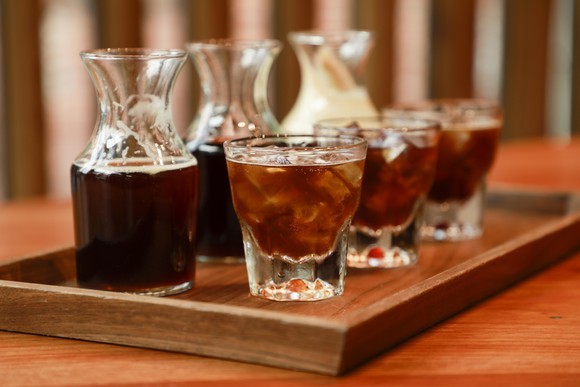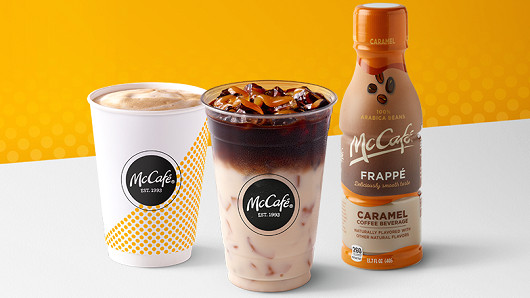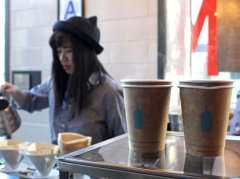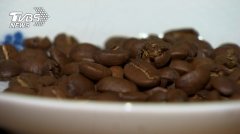Starbucks and McDonald's fight against the season for iced coffee, but China still likes to soak Chinese wolfberry.

For professional baristas, please follow the coffee workshop (Wechat official account cafe_style)
Foreigners have a good physique and can eat ice all the year round.
Coffee giants have found an interesting phenomenon. Even in winter, you can see many men and women wearing gloves and holding iced coffee.
Because of consumers' fondness for cold drinks in recent years, McDonald's, Starbucks and Dunkin' Donuts have started a war of iced coffee, launching innovative products one after another to grab consumers.
Starbucks and McDonald's are fighting for iced coffee, but it may not be suitable for China on the thermos cup.
McDonald's enters the game, the competition is fierce.
Last year and this summer, cold coffee from stores such as Starbucks and Donndole became popular at an incredible rate. Krypton 36 has introduced that cold-extracted coffee takes at least 12 hours to brew and tastes better with lower acidity.
McDonald's is not involved in the battle for cold coffee, but has repeatedly stressed the importance of its own cafe McCafe. McCafe is a small "cafe" embedded in McDonald's, featuring cold / hot coffee, cakes, macarons and other drinks and snacks. McCafe is found in many McDonald's restaurants in China.
Recently, McDonald's and Coca-Cola have reached a partnership to launch McCafe Frappe ready-to-drink drinks, opening a new way for them to sell only hot coffee in the past. Although McDonald's may not be the first choice for coffee lovers, the price advantage is hard to shake. After all, McDonald's small cups of coffee usually sell for only $2 (9.5 yuan in China), much lower than Starbucks.
Starbucks and McDonald's are fighting for iced coffee, but it may not be suitable for China on the thermos cup.
Both Starbucks and Dawn are busy. Dawn is happy to launch a new ready-to-drink production line and open up e-commerce channels for sales. Starbucks is rapidly expanding its bottled product line, not satisfied with iced coffee and cappuccino. We also need to come up with energy drinks and newly extracted coffee.
Fancy Innovation of Ice Coffee
If you want to catch the hearts of consumers, you must first grab their stomachs. For FMCG, it means constantly pushing new products and making trial and error, and the same is true in the field of iced coffee.
McDonald's is the most conservative of the three companies, and coffee drinks have not made much progress. Starbucks and Donndole have dedicated R & D teams to look for new "iced coffee" products that have no seasonal fluctuations and make people want to drink all year round.
Donndole gave up on Cool Coolatta and made every effort to develop a new Frozen Dunkin coffee to compete with Starbucks' popular Frappuccino all year round. Frozen Dunkin uses a special extract of 100% Arabica coffee to improve the original Coolatta formula.
Although Starbucks already has Frappuccino, it has been trying to promote a variety of limited-edition flavors of Frappuccino and other iced drinks. This fall, Starbucks will launch a cold-pressed coffee Cold-Pressed Espresso, similar to cold-extracted coffee, but distilled in a slightly different way, which takes less than 12 hours to make, and Starbucks is applying for a patent.
The cold-pressed coffee will be the first to be launched at Roastery, a high-end Starbucks bakery in Seattle, and may be promoted globally in a richer form after a successful attempt.

The market for cold drinks is huge.
Although none of the three companies specifically disclosed the sales of their cold drinks, according to some data provided by Starbucks at the 2016 investor conference, the size of the cold drinks market is imaginative. Starbucks believes that revenue from its cold coffee business is expected to double by 2021, with sales of the overall cold drink portfolio rising from 35 per cent in 2013 to nearly 50 per cent in 2021.
In addition, Starbucks cited a report that iced coffee consumption has increased by 75% over the past decade, and sales of cold coffee have increased by 338.9% between 2010 and 2015. The trend of iced coffee is creating a lot of opportunities and there is a lot of room for development.
In the case of Starbucks, cold-extracted coffee has helped them attract millennials with unique tastes and save some "middle-and high-end" consumers, while Frappuccino has attracted coffee fans who are looking for different tastes.
Although McDonald's is not innovative, it is just "copying" the other two iced coffee products, which may not cultivate loyal consumers, but it is likely to win with low cost and scale, after all, as long as existing fast food fans, each person has an extra cup of iced coffee, it will bring a lot of extra benefits.
However, the future of Starbucks, McDonald's and Donndole in China is uncertain when it comes to developing iced coffee, as they face very strong competitors such as hot water and thermos cups.
From January to June 2017, China's cold drink market was in a period of high growth, with a compound growth rate of more than 33%, according to data from Nielsen and other institutions. However, China's per capita cold drink consumption is still at a low level of 4 litres, while the US has reached 18.4 litres.
In China, cold drinks also have strong seasonality, and summer is often the peak of consumption. According to the Chinese custom, they are not able to eat popsicles and drink cold drinks freely in the cold winter, and most of them will soak Chinese wolfberry in a thermos cup. When traveling abroad, we often encounter the embarrassment of "how do Chinese people drink hot water".
In addition, from the perspective of the coffee market, we are far from reaching the scale of Europe and the United States, and consumers have not yet been fully cultivated, especially in low-line cities. In addition to foreign brands, there are few local coffee brands with brand tone, clear target consumer groups and differentiation in the Chinese market. The coffee market has great potential, but it is not yet explosive.
So the question is, will you have a cup of iced coffee in autumn and winter?
Important Notice :
前街咖啡 FrontStreet Coffee has moved to new addredd:
FrontStreet Coffee Address: 315,Donghua East Road,GuangZhou
Tel:020 38364473
- Prev

It's turned upside down? Nestl é buys 68% controlling stake in Blue bottle Coffee for $500 million
The exchange of professional baristas please follow the news on the morning of the 15th Beijing time of the coffee workshop (Wechat official account cafe_style). According to the Financial Times, Nestl é will spend $500m to acquire a 68 per cent stake in Blue Bottle Coffee, a well-known US coffee chain. The deal values Blue bottle Coffee at more than $700 million. Blue bottle Coffee 2002
- Next

Japanese study: Drinking coffee and green tea daily can prevent stroke
Professional barista exchanges please pay attention to coffee workshop (Weixin Official Accounts cafe_style) Japanese research shows that daily intake of coffee and green tea can prevent stroke, the study published in the American Heart Associations journal Stroke. Dr. Yoshihiro Okubo of Japan's National Cerebrocardiovascular Center said the study recruited eight people.
Related
- What ratio of water temperature and ground does the smart cup method use to press coffee? The difference between brewed coffee and filtered coffee?
- What is the standard process for the purpose of coffee cup testing? What is the difference between hand-brewed coffee and cup testing?
- How to use hand-brewed coffee paragon small golden balls? How does cold coffee lock in the aroma of coffee?
- Is American coffee black? What is the difference between American coffee and drip coffee?
- Unexpected! Well-known tea beverage brand Lele Tea will withdraw from the Zhengzhou market!
- Starbucks enters the fashion and beauty industry?! Netizen: Give me an ice American eye cream
- Why can American refills for free? The difference between Americano and American drip pot coffee
- Being chased out of the rain in front of Starbucks?! Store: Sheltering from rain under umbrellas poses a safety hazard
- The white moonlight has changed?! Lucky launches "Big Winter Pear American"
- Hand-brewed coffee three-stage method, high-sweet and universal brewing method to share! What does the high sweet water level of hand-brewed coffee mean?

